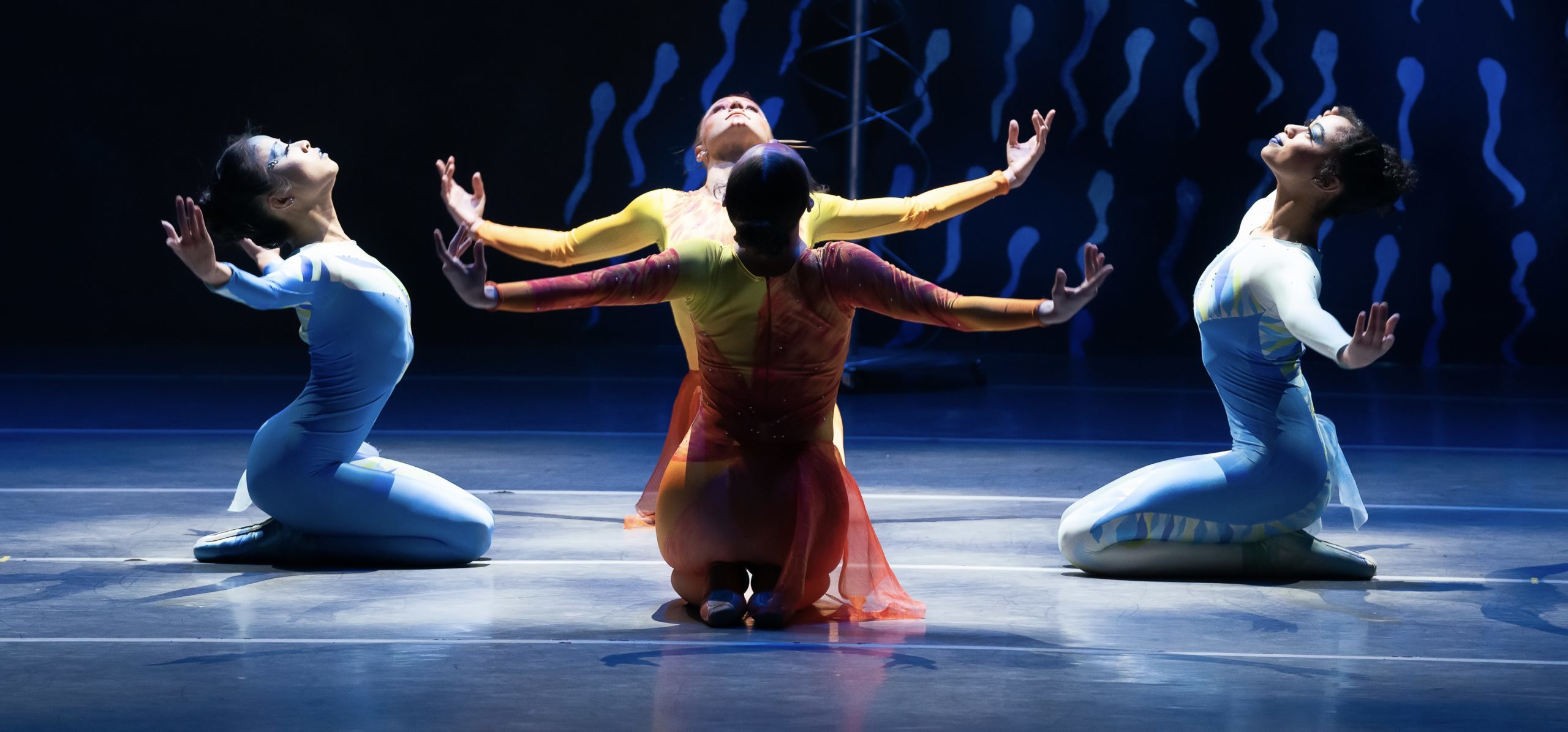
American Repertory Ballet Kaleidoscope Review: Interpreting Reflections
The Dance Herald by Nadia Vostrikov
In a program named after constantly changing patterns, American Repertory Ballet’s Kaleidoscope lived up to the title with a range of dance from classical to contemporary. Two group pieces and two pas de deux, the evening’s line up was even laid out in kaleidoscope-like symmetry.
Taking inspiration from Salvador Dali’s painting Swans Reflecting Elephants – a surrealist image of swans peering into their morphed elephant reflection – Ryoko Tanaka’s Hindsight imitated the art through duos, zoological gestures, and an enchanting pas de deux.
Tanaka has a firm grasp on vocabulary, knowing when to refer back to theme steps and when to incorporate something new.
In her thematic bag of moves: one arm bent at the elbow with fingertips to the chest and palm to the floor, a pirouette opening to an extended arabesque, stag leaps.
Movement remained a clear thread thoughtfully woven from section to section – elevated by Tanaka’s organic transitions and accompaniment of Ian Howells’ new composition, an inspirational, pastorale-like piano and cello number.
Accolades must also be given to Jason Flamos for the dramatic lagoon of light poured across the stage.
The peak of the piece is a pas de deux featuring emotive dancing from Annie Johnson and Aldeir Monteiro. Johnson changes from a burnt orange dress into black and Howells’ instrumentation becomes tender yet foreboding. Between Johnson’s costume and slackened body, it’s clear this is a duet of loss. Tanaka juxtaposes the simple beauty of the pas de deux with sculptural shapes and sharp upper body configurations in the group work – duality echoes throughout.
Set between the opening and closing group numbers were the two antipodal pas de deux, one to the jazzy Bewitched, Bothered, and Bewildered song and the other to Leo Delibes’ classic Act III Coppélia.
Claire Davison’s Bewitched featured Erikka Reenstierna-Cates and Elias Re in a whimsical, characterized, whirlwind romance. Taking cues from the music, Reenstierna-Cates wobbles and sways to the crooning lyrics “After one whole quart of brandy/Like a daisy, I’m awake”.
Familiar with Davison’s work, I am always happy to see her name on a program. Davison is unafraid of humor and open to riding any inspiration that floats her way (I once saw a piece in which she was inspired by a beach towel). Using non-conventional connections, a foot lifting a head, a cheek resting in a palm, her humor is subtle yet refined and always nestled ever so nicely in the music.
Delibes Duet, choreographed by Artistic Director Ethan Stiefel, is a more classic approach, using the age-old ballet formula of pas de deux, two variations, and coda. Decked in gorgeous silver costumes, the ballerina in a tutu with lapels revealing shimmering crystals and the male dancer in a similar shimmering lapeled tunic, Janessa Cornell Urwin’s costumes are a beautiful nod to the prototypical uniform with a 21st century upgrade.
Like the costumes, Stiefel offers us classical ballet with a twist.
Traditionally, male and female dancers have certain roles to fill. From the attire to how they stand on stage, their expectations are split by gender. Stiefel challenges that expectation.
A few bars in, the female dancer stands in a pose more commonly taken by the prince in full-length ballets; one straight leg, toes pointing slightly out and the other leg bent slightly at the knee with the heel tucked against the other foot. It may seem like nothing, but it’s a pose rarely done by a ballerina in pointe shoes and a tutu.
The pas de deux, luscious and provocative in its subtle challenges of the status quo, is absolutely refreshing. Duo Lily Krisko and Tiziano Cerrato are spirited and green, both new apprentices with the company, and rose to the difficult challenge. The steps following the pas section were increasingly demanding but the kind of dance where the audience is totally clued into the challenge and rooting the dancers on.
Influenced by the namesake of the program, Da’ Von Doane’s “Kaleidoscope Mind” was the most literal interpretation of the evening.
Grace Lynn Haynes’ designs featured a swirled backdrop and metal sculptures, later used as a central point for the end kaleidoscope formation, brought a crowded heaviness to the stage. Layered with fire and ice style unitards and dramatic face paint, there was a lot to take in when the curtain went up. While it was refreshing to see stage sets after three unaccompanied pieces, this may have been a case of too many ideas.
Working in mostly symmetrical formations and clean, balletic steps the steady tone of the piece mirrored the repeated, minimalistic music of Steve Reich. Intricate arm work was introduced mostly when the lower body was static, like that of an anchor or perhaps the central node of a kaleidoscope window.
Doane lets the piece fade out instead of culminating, delivering an introspective calm, an unusual choice for the closer.
Mid-way through the evening there was a minor curtain malfunction causing a small extended pause. Stiefel appeared on the stage to jovially remind everyone “this is a live performance, obviously, which is what makes it so special.”
American Repertory Ballet is a special company indeed.
Featured Photo for this American Repertory Ballet Kaleidoscope review of (clockwise) Nanako Yamamoto, Annie Johnson, Emily Cordies-Mason, Michelle Quiner in Da’ Von Doane’s Kaleidoscope Mind. Photo by Kyle Froman.